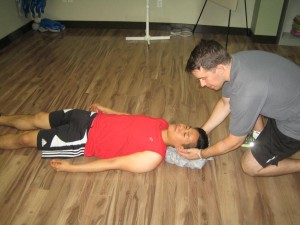Based on studies, it is estimated that construction workers work frequently on scaffolds or also called as elevated work platforms. These scaffolding structures are usually made out of pipes and boards that are connected with supportive hardware couplers along with base foundations in order to safety hold and distribute the weight. Understandably, construction workers are prone to scaffolding injuries. http://youtu.be/FpUI5LXmpNk
Injuries form falls due to failed scaffolding
Failure in the construction of the scaffolding due to incorrect assembly and not properly supported structures has been one of the causes of falls. Causes include loose connections, missing bolts, overloading, unsupported bases and breakage of old or corroded parts. Scaffolding injuries can occur once an individual falls at a tall height which includes head injuries, broken bones, lacerations, bruises, crushed body parts and punctures. Workplaces should always ensure that all the scaffolding equipment are properly maintained in the best condition as well as frequently checked on a regular basis. Even though these precautions are observed, it cannot be denied that scaffolding injuries are increasing in rate due to the degrading safety factor. In most cases, it can also be traced to negligence in any form. It can be as simple as constructing poorly or not properly maintaining the scaffolding or even the lack of safety measures such as nets or guard rails.
Injuries from falling off the scaffolding

If proper safety measures are not observed while on the scaffolds as well as working without using safety harnesses, an individual might fall off the scaffolding, thus resulting to injury or even death. Running or jumping on the scaffolding can cause imbalance to the structure, equipment and other people using the structure. Take note that falls tend to vary in severity depending on the height involved. The scaffolding injuries typically include contusions, broken bones, cuts, hemorrhage, head injuries and even death. If you want to learn how to provide the appropriate first aid care for these injuries, click here. In case of head injuries, it can include concussions which are the most common type of traumatic brain damage, fractures to the skull and scalp wounds. Obviously, falling from a height in which the head is injured can cause bleeding either in the brain tissue or in the layers surrounding the brain – subarachnoid hemorrhage, extradural hematoma or subdural hematoma.
Injuries caused by dropped items
Safety training and procedures must be emphasized in any workplace that involves the use of scaffolding to ensure the safety of the workers as well as people who pass by the structure. Any item or equipment that was dropped from a tall height can injure, severely disable or even kill. Head injuries from falling objects can cause brain damage, permanent disabilities and even death.
Crushing and pinch scaffolding injuries
The hands, fingers, feet and arms can sustain crushing and pinch injuries from scaffolding that is not properly assembled. The supports and railings must be properly checked to ensure proper assembly, safe supports and secure connections. For those who work at heights, crushing and pinch injuries while on the scaffolding can startle people, thus resulting to falls and slips.
